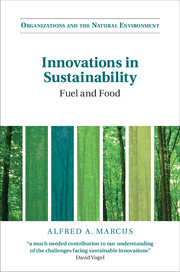Book contents
- Frontmatter
- Dedication
- Contents
- List of figure and tables
- Foreword
- Acknowledgments
- Introduction the path to sustainability
- Part I Funding sustainable startups
- Part II Business models
- Part III The macroenvironment and industry context
- Part IV Finding customers
- Part V Competition between mission and non-mission based businesses
- 9 Consensus capitalism: Whole Foods and Walmart
- 10 Sustainability's next frontier: DuPont and Monsanto
- Concluding observations: the journey continues
- Index
10 - Sustainability's next frontier: DuPont and Monsanto
from Part V - Competition between mission and non-mission based businesses
Published online by Cambridge University Press: 05 August 2015
- Frontmatter
- Dedication
- Contents
- List of figure and tables
- Foreword
- Acknowledgments
- Introduction the path to sustainability
- Part I Funding sustainable startups
- Part II Business models
- Part III The macroenvironment and industry context
- Part IV Finding customers
- Part V Competition between mission and non-mission based businesses
- 9 Consensus capitalism: Whole Foods and Walmart
- 10 Sustainability's next frontier: DuPont and Monsanto
- Concluding observations: the journey continues
- Index
Summary
What steps should DuPont and Monsanto next take in their sustainability journeys? Should DuPont, a more diversified company than Monsanto, focus more exclusively on food and agriculture? Should it become more like the mission-based Monsanto, whose focus was almost exclusively in these areas? Which products should DuPont and Monsanto make? Which markets should they serve?
No matter which products and markets they chose, they would have to defend themselves. What were the implications of DuPont's and Monsanto's product and market choices for society? To what extent would the next steps in their sustainable journeys affect their growth and profitability? To what extent should these companies dedicate themselves to playing a leading role in eliminating world hunger? DuPont and Monsanto had to decide what they should do next.
DuPont's and Monsanto's sustainability journeys
In its 2013 sustainability report, DuPont wrote that its journey had evolved from environmental compliance, to reducing its operational footprint, to market-driven efforts to produce sustainable solutions for the world. It identified its future business opportunities in terms of sustainability goals: (i) harnessing renewable energy sources; (ii) protecting ecosystems; (iii) reducing fossil fuel dependence; and (iv) safeguarding the environment. These goals were meant to motivate the company's employees to exercise their technical prowess in researching and solving the problems of society.
- Type
- Chapter
- Information
- Innovations in SustainabilityFuel and Food, pp. 296 - 331Publisher: Cambridge University PressPrint publication year: 2015



